
Title: Tropical Fish Handbook
Author: Guenther-Lothar Schott
Release date: June 24, 2020 [eBook #62463]
Most recently updated: October 18, 2024
Language: English
Credits: Produced by Stephen Hutcheson and the Online Distributed
Proofreading Team at https://www.pgdp.net

GOLDFISH
AND
31 POPULAR TROPICALS
ILLUSTRATED AND DESCRIBED
“Twice happy is the man who has a Hobby,
He has Two Worlds to Live in.”
A book of practical information for the beginner, containing illustrations and descriptions of Tropical Fish, Goldfish, Scavengers, Turtles and Aquarium Accessories.

Tenth Edition 1953
Copyright 1945
By
GUENTHER L. SCHOTT
New York, N. Y.
PRINTED IN U. S. A.
For the beginner, the happy family collection is of most interest. Here in one large tank he can observe the interesting habits, shapes and colors of a great variety of fish. If he desires he may remove them to separate tanks during breeding periods. The danger of cross breeding in the community tank is practically eliminated by the presence of a pair of each species.
The following fish are discussed in this handbook, those marked * being recommended for the community tank.
Bad tempered fish may appear in some normally peaceful species and vice versa.
Also fish which may make trouble in a small aquarium may be peaceful in a large well planted one.
Live Bearers (young are born alive) *Guppy, *Swordtail, *Moon or Platy, *Sailfin, *Black Mollienisia, *Helleri, *Mosquito Fish, *Platy Variatus.
Labyrinth (breathe air taken from surface, bubble nest builders) Paradise, Bettas, *Dwarf Gourami, Three-Spot Gourami.
Cichlids (Egg layers, guard eggs and fry) Jewel Fish, *Angel Fish, Mouth Breeder, Blue Acara, Orange Chromide.
Danios (Egg droppers) *Zebra, *Pearl Danio, *Giant Danio.
Barbs (spawn on plants like goldfish) *Rosy Barb, *Barbus Oligolepis.
Characins (Deposit adhesive eggs on plants) *Silver Tetra, *Tetra Von Buenos Aires, *Tetra Von Rio, *Blood Fin, *Pristella Riddlei, *Head and Tail Light. *Featherfins, *Black Tetra, *Neon Tetra.
Cyprinodontidae (Egg droppers) *Medaka, *Panchax.
Cyprinidae (Egg droppers) *Rasbora.
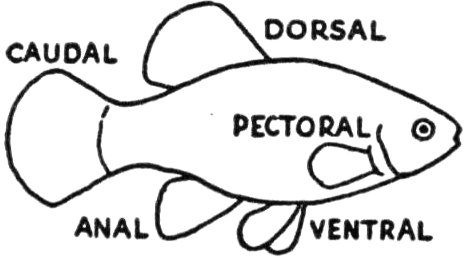
The above illustration will assist the reader in locating the markings of the fish described in this book.
Much of the future enjoyment of your aquarium will depend upon the care with which it is selected, and its proper location.
The aquarium should be rectangular, and the depth should not exceed its width. The larger the tank the more satisfaction you will receive from it—it is easier to balance, maintains a more uniform temperature, and allows space to add to your collection.
The principles of the balanced aquarium are very simple. Fish breathe oxygen (which they obtain from the water) and exhale carbon dioxide. Thriving plants absorb the carbon from the carbon dioxide and liberate the oxygen. This maintains a high oxygen content in the water necessary to maintain healthy fish. No balanced aquarium can be maintained without scavengers to consume bits of decaying food and plants. Fish, plants and scavengers depend upon each other in the balanced aquarium.
Aquarium should be located where it will receive one or two hours of direct sunshine daily and plenty of strong light all day. When aquarium is located cover bottom with one or two inches of well washed coarse sand. (For practical purposes sand may be considered well washed when water runs clear.) Be sure that aquarium has been carefully washed before introducing sand. Sand and aquarium may be washed in strong solution of rock salt—RINSE THOROUGHLY.
Now fill aquarium about half full of water and set in plants. Be sure that over one half your plants are excellent oxygenators. Vallisneria and Sagittaria should not have crowns buried when planting. Plant tall plants in back or in corners and smaller ones in front. You cannot use too many plants—BUT ONLY GROWING AND HEALTHY PLANTS LIBERATE OXYGEN.
Fill tank, pouring water on piece of paper floating on top or into cup submerged in tank to avoid uprooting plants. Allow water to stand 24 hours. Be sure it is the right temperature for fish it will contain. Add snails and scavengers. PROVIDE GLASS COVER as tropicals are noted for their jumping ability. Some type of heater should be provided for the aquarium, in order to maintain a uniform temperature during the winter months.
Fish may now be introduced, care being taken not to place too many fish in a new tank until plants have had sufficient time to multiply. The dissolution of uneaten food, dead snails, plants, etc., frequently produces more food than can be consumed by the plant life present. At this point Algae frequently steps in and the tank becomes green or cloudy and foul smelling.
To avoid this condition, avoid too many fish in aquarium, siphon off dirt on bottom frequently, remove plants that are not thriving, cut down light when thread algae becomes a nuisance.
Water in a balanced aquarium will remain crystal clear for months.
Always keep glass cover on aquarium. It helps maintain a more uniform temperature, and keeps fish from jumping out. It may be raised slightly but this is not necessary.
Always use net in handling fish.
Do not use pebbles in aquarium—food gets into crevices where scavengers cannot reach it—causing water to foul.
Always keep a thermometer in aquarium.
Avoid metals in aquarium. Lead is safe as it does not dissolve.
Rooted plants should not have crowns buried when planting—Fig. 1.
KEEP BOTTOM OF AQUARIUM CLEAN—remove all sediment with dip tube—Fig. 2.
To remove water—use either automatic siphon—Fig. 3—or siphon with rubber hose.
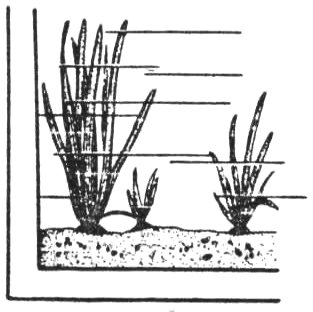
FIG·1
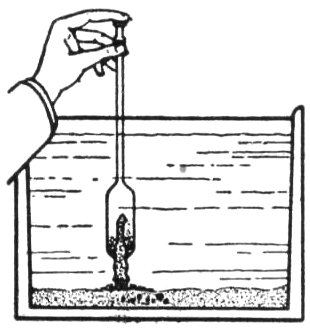
FIG·2

FIG·3

| ANACHARIS. | LUDWIGIA. | VALLISNERIA. | SAGITTARIA. | CABOMBA. |
| DUCK WEED. | ||||
| HAIR GRASS. | SOUTHERN SPATTERDOCK. | VALLISNERIA. | MYRIOPHYLLUM. | SALVINIA. |
Anacharis: Fair oxygenator—planted or floating—needs abundance of light.
Ludwigia: Fair oxygenator. Leaves—top green, underneath red.
Sagittaria: Excellent oxygenators, three varieties: NATANS—long narrow leaves; GIGANTEA—broad stocky 8″ leaves; SUBULATA—(dwarf) 4″ to 6″ narrow leaves.
Cabomba: Little value as oxygenator—fanlike green leaves.
Hair Grass: Fair oxygenator—rapidly covers floor with 4″ grassy needles.
Southern Spatterdock: Ornamental—broad bright green leaves.
Vallisneria: Excellent oxygenator—15″ long—multiplies rapidly by runners.
Myriophyllum: Ornamental—excellent for spawn of adhesive egg layers.
Salvinia: Floating—¼″ leaves covered with velvety hairs.
Duck Weed: Ornamental bright green floating plant.
Riccia: Very fine bright green floating plant—valuable in spawning bubble nest builders, especially Dwarf Gourami.
Cryptocoryne: Leaves top dark green, underside dark red. Needs some soil, slow grower. Very decorative and necessary in spawning some species.
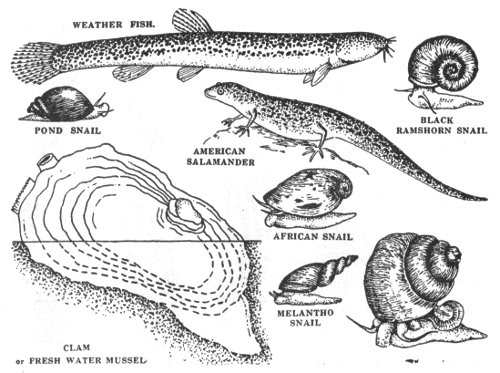
| WEATHER FISH | BLACK RAMSHORN SNAIL | |
| POND SNAIL | AMERICAN SALAMANDER | |
| CLAM or FRESH WATER MUSSEL | AFRICAN SNAIL MELANTHO SNAIL | |
Melantho (Trumpet) Snail: Very active—multiplies rapidly—consumes algae.
Pond Snail: Very active and useful—a fast moving fellow.
Black Ramshorn Snail: Multiplies rapidly—excellent scavenger.
Coral Snail: Same as Ramshorn with coral red body, and shell.
African Snail: Good scavenger—light yellow brown—dark spots.
Australian Snail: Similar to Pond but bright scarlet in color—very active.
Catfish: (Corydoras Paleatus) most popular scavenger. Look for full description on page 26.
American Salamander: Brown with red and black spots—vest yellow and brown.
Clam or Fresh Water Mussel: Filters all floating matter from water leaving it crystal clear. Must have large tank or pool and several inches of sand in which to work.
Snails will eat eggs of egg-laying fish.
To breed snails—place in separate tank and feed lettuce. Well
fed snails lay an abundance of eggs, resembling a gelatin like
mass attached to plants and glass. Fish will eat snail eggs.
Salt will kill snails—when using salt treatment remove snails.
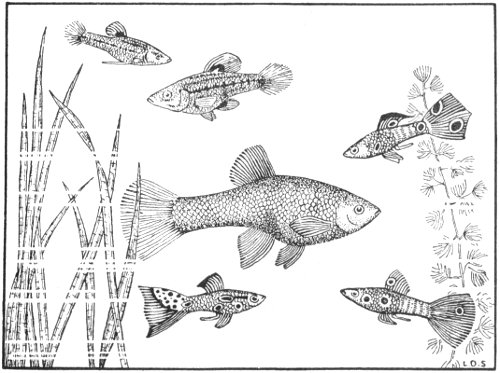
average size
Color: Numerous black bands adorn gray sides—black horizontal line extends from eye to caudal. Red edged dark spot on dorsal.
Breeding Habits: Live bearers—Females produce several young every few days during breeding season. Young are hardy and mature in about 6 months.
Temperature: 65° to 75° F.
Temperament: Peaceful.
Color: Male—two males are never precisely alike. Every color of the rainbow is present, intermingled with irregular black spots and bars. Female—dull grayish green.
Breeding Habits: Live Bearers—mature females produce from 35 to 50 live young every 5 weeks. Presence of young is indicated by darkened area anterior to anal fin. “Heavy” females may be removed to separate vessel, heavily stocked with plants—particularly floating plants toward light. When young are born they seek safety among plants. Remove female to prevent her eating young. Young are ready to take fine food in a few hours. Guppy seem to thrive under fairly crowded conditions.
Temperature: Thrive and breed at 65° to 80° F.
Maturity: Males 2 to 3 months—Females 4 month. Males less hardy.
Temperament: Very peaceful. Males very active.
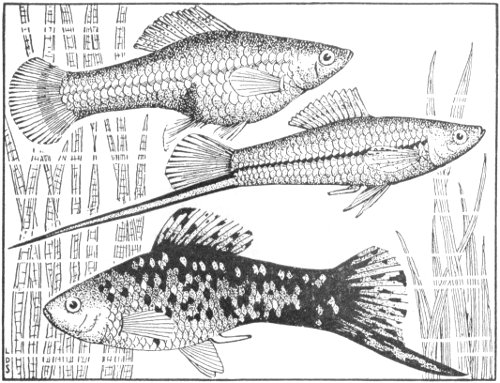
average size
Color: Male—body blue green, red line on side. Large dorsal with reddish dots. Ornamental sword may be yellow, orange or green, edged with black. Female—resembles male in color, lacks sword. (Both male and female CRESCENT SWORDTAIL have black crescent at base of caudal.)
Breeding Habits: Live bearers—have 25 to 100 live young every 6 or 7 weeks. When female is “heavy” place her in large vessel heavily stocked with plants. Young swim from mother, seeking safety among plants usually at bottom toward light. Remove female—she will eat fry.
Temperature: 70° to 85° F. Breed best at 75° F.
Maturity: Breed at about 9 months. Male resembles female until full grown; then anal changes to reproducing organ and “sword” develops.
Temperament: Very peaceful. Due to rivalry, stronger male will bully others.
Mating a virgin female Swordtail and Platy male, the young inherit the general color of the male and body type of the female, often becoming larger than either parent. Some males develop short sword. A percentage of the offspring are sterile.
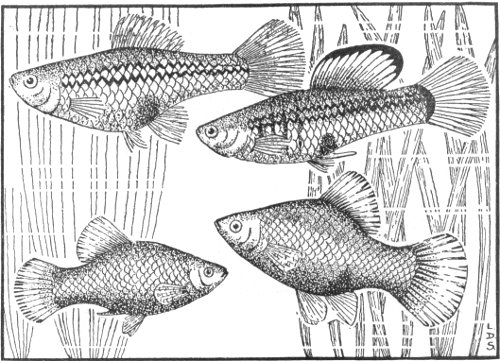
average size
Color: Large dorsal, yellow with black edge, caudal reddish, body various colors intermingled. Female, similar to female swordtail in color and markings. Male has spot resembling gravid spot on female. Color and markings vary.
Breeding Habits: Live bearers (same as swordtails). Do not breed true to color.
Temperature: 72° to 80° F.
Maturity: 5 to 8 months.
Temperament: Peaceful, very hardy.
Color: RED MOON—deep rich red. GOLD MOON—gold body, red dorsal fin, BLUE MOON—blue body, black crescent at base of caudal. (Black Crescent may appear on Red and Gold Moons.) BLACK MOON—black body sometimes with greenish sheen, also found with red heads, (Black Helmet Moon), GOLD WAGTAIL—Gold body with black fins and black caudal. RED WAGTAILS—deep red body with black fins and black caudal.
Breeding Habits: Live bearers—15 to 30 young every 6 to 9 weeks. Breeding habits same as swordtails, except most young moons come to top. Cross breeding with swordtail common, producing beautiful hybrids (HELLERI) larger than either parent and assuming color of male (MOON).
Temperature: 70° to 80° F. Maturity: 4 to 6 months.
Temperament: Very peaceful. Fry must be kept very warm.
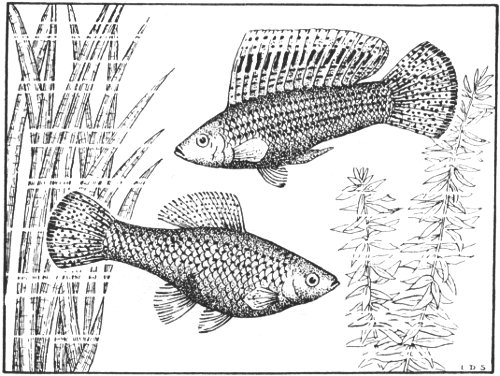
About one half size
Color: Male—body olive green, black stitching; large dorsal fin (sailfin) lavender and orange spotted with black; caudal, orange and light blue. Female—similar to male but without large dorsal.
Breeding Habits: Live bearers—have 20 to 100 young at irregular intervals. All Mollienisia are hardy but females must not be moved to another tank when young are expected. This frequently causes young to be born prematurely and few will survive. Moving female or undue excitement at this time may cause death of female. Provide ample vegetation in tank. Sailfins are not very cannibalistic but it is always safest to remove fry for several weeks. Young are ⅜″ long when born.
Temperature: 45° to 85° F. Breed best at 70° F.
Maturity: 9 months.
Temperament: Very peaceful.
In breeding Mollienisia, no two varieties should be kept in the same tank as they will cross breed. Each variety should be provided with a separate tank. (This is also true of the moons). Only very careful intelligent selective breeding has produced the Black Mollienisia, later the Sailfin Black Molly, and most recently, Black Molly Sailfin with an orange bordered dorsal.
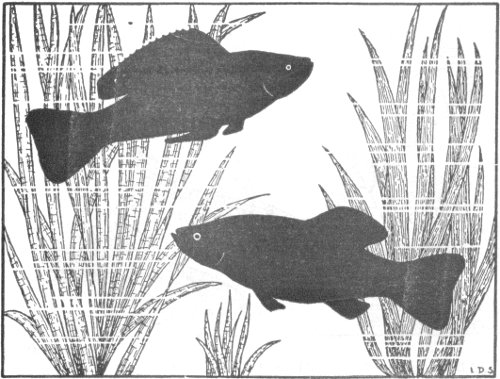
average size
Color: Both male and female coal black.
Breeding Habits: Live bearers—15 to 25 young born at irregular intervals throughout the year. Young when born are large and black. Turn gray in a few weeks and then gradually turn black. Female should never be moved when young are expected—as this usually results in loss of young and frequently loss of female. (See Sailfin). Young are fairly safe with parents if ample floating plants are provided. “Mollies” are algae eaters. Black Mollienisia have been crossed with Sailfins producing the beautiful BLACK MOLLIENISIA SAILFIN.
Temperature: 65° to 80° F. Breed best at 75° F.
Maturity: Good male becomes black in about 6 months. Female about 18 months. Breed at 9 months. Males less hardy.
Temperament: Very peaceful.
“Mollies” are heavy eaters, and largely vegetarians. Some algae should be present.
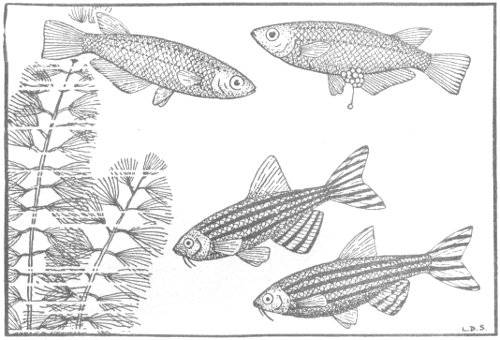
average size
Color: Male and female light lemon yellow. Male slim like Zebra—sometimes called “Golden Danio.” Female—slightly heavier.
Breeding Habits: Egg layers—these interesting and attractive fish are the easiest of the egg layers to breed. Eggs cluster about anal region of female like bunch of grapes. Here they are carried for several hours and later brushed off on plants where they become attached. Eggs can be easily seen hanging to plants. Fish seldom bother eggs but it is safest to remove plants containing eggs to another jar. Fry hatch in 10 to 14 days. Feed fry infusoria. Never have snails in tank containing fish eggs.
Temperature: 45° to 80° F. Spawn best at 70° F.
Maturity: Mature in about 6 mos.
Temperament: Very peaceful.
Color: Both male and female striped from eyes through tail with alternate lines of blue and silver. Underparts of male slightly yellowish—female silvery white. Female—deeper in body.
Breeding Habits: Egg layers—non-adhesive eggs fall to bottom. Cover bottom of breeding tank with several layers ½″ pebbles or glass marbles, not over 3 inches of water above marbles. Place male and female (kept separate several days) in prepared tank. Spawning usually takes place within 24 hours. Spawning is preceded by very fast swimming. Remove parents after spawning. Fry hatch in 2 to 8 days. Feed fry infusoria.
Temperature: 45° to 80° F.
Maturity: Breed when 4 to 5 months.
Temperament: Peaceful, swim in school, constantly moving.
(See Pearl Danio.)
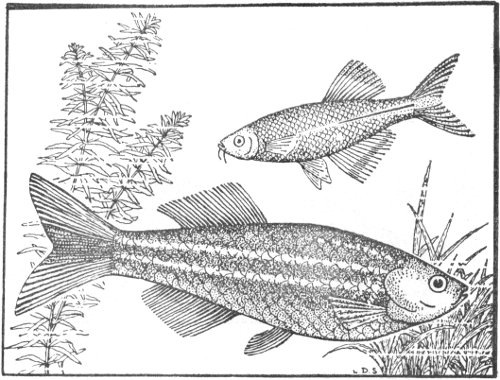
average size
Color: Iridescent mother-of-pearl and opal tints. Dull red line through center of body and tail. Female—slightly heavier.
Breeding Habits: Egg layers—prepare aquarium same as for Zebra. Long tank best for both. As they snatch eggs when they turn, long tank eliminates many turns. Advisable to use two males to one female. (See Zebra.)
Temperature and Temperament: Same as Zebra.
Maturity: 6 to 8 months.
Color: Deep metallic blue with two horizontal stripes of yellow
gold.
Female—slightly heavier.
Breeding Habits: Egg layers—very small semi-adhesive eggs deposited on plants. Fry need great amount of food. Remove parents after spawning. (see Rosy Barb.)
Temperature: 60° to 80° F.
Maturity: 8 to 10 months.
Temperament: Peaceful, but will attack small fish.
Danios (Zebra, Pearl and Giant) are always active, and are large consumers of oxygen, therefore are more susceptible to the effects of lack of sufficient oxygen in the aquarium. Being fast swimmers and especially fond of their own eggs, water in the breeding tank should not exceed 6 inches and they should be removed as soon as spawning is over.
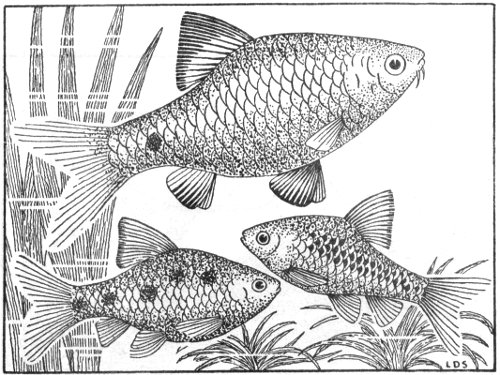
average size
Color: Silvery green, dark spot at base of caudal. Male has black dash on dorsal and takes on rosy hue during spawning season.
Breeding Habits: Egg layers—lay eggs on fine plants similar to goldfish. Stock aquarium well with fine plants like Myriophyllum or Cabomba, weight down ends with a stone. Separate male and female for a few days. Spawning usually takes place within 48 hours after pair is placed together. After spawning is completed remove plants containing eggs and place in tank free from other fish and scavengers. Fry hatch in about a week and should be fed with Brine Shrimp.
The following Barbs are prettily colored and easy to take care of. Their breeding habits are like those of the Rosybarbs.
- BARBUS SUMATRANUS
- BARBUS EVERETTI (CLOWN BARB)
- BARBUS SEMIFASCIOLATUS (HALF BANDED)
- BARBUS SEMIFASCIOLATUS var. Schuberti, (GOLD BARB)
- BARBUS NIGROFASCIATUS
Temperature: 45° to 80° F. Spawn best at 70° to 80° F.
Maturity: Mature in about 9 months.
Temperament: Peaceful.
Color: Male—Large scales with blue-black spot, all fins orange-red with dark edge. Female—Duller in color with 4 or 5 black spots on sides.
Breeding Habits: Egg layers—Stock aquarium with Cabomba. Male turns almost black during spawning period. Remove both parents as soon as eggs are deposited on fine plants. Fry hatch in about 72 hours.
Temperature: 70° to 80° F.
Maturity: 10 months.
Temperament: (Peaceful.)
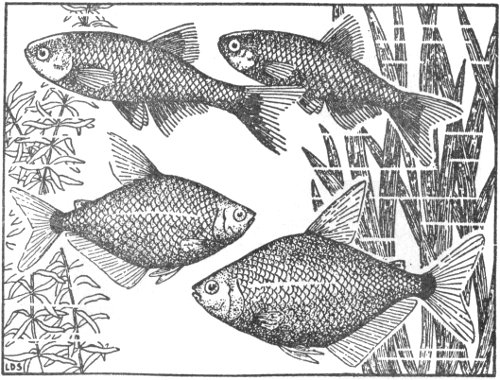
average size
Color: Iridescent steel blue with deep red fins. Sex determined same as Silver Tetra.
Breeding Habits: Egg layers. Use large tank, cover bottom with fine plants, and ample tall ones. Fish spawn at surface, some eggs adhering to tall plants, others falling. Remove parents. Fry appear in about 24 hours. Feed Brine Shrimp. Fry grow rapidly.
Temperature: 70° to 78° F.
Temperament: Peaceful.
Color: Steel blue body covered with very fine bright silver scales. Body very thin. Large black spot at base of caudal. Tetras are all easily identified by the small adipose fin between dorsal and caudal. Male slightly smaller with invisible processes on anterior tip of anal which catch in fine net. Sex is determined in this way.
Breeding Habits: Egg layers—lay great quantities of adhesive eggs on fine plants. Plants or parents should be removed as soon as spawning is completed. Fry will make their appearance in a few days. Be sure there are no snails in tank with eggs.
Temperature: 70° to 90° F.
Maturity: 6 to 8 months.
Temperament: Very active. Not for community tank.
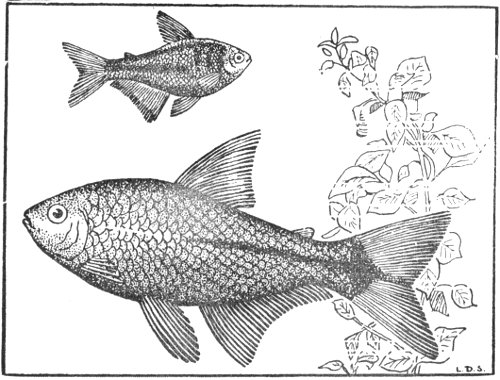
average size
Color: TETRA FROM RIO—body bright silver—3 black bars near head; fins brilliant red edged with black; black edge on anal of male wider than on female. During mating season red runs well into body. TETRA FROM BUENOS AIRES—body bright silver, fins blood red. Large diamond shaped spot at base of caudal. Sex determined same as Silver Tetra.
Breeding Habits: Egg layers. Use 15 gallon tank, 6 to 8 inches of water. Stock tank heavily with Cabomba, Myriophyllum, or other fine floating plants, also a thicket on bottom. Semi-adhesive eggs are deposited on plants, some sinking to bottom. Best results are obtained with 2 males and 1 female. Remove parents after spawning is completed. Fry appear in about 3 days. Tiny fry hang on plants and sides of aquarium about 3 days. Tetras may not spawn immediately—have patience.
Temperature: 70° to 90° F.
Maturity: From Rio—8 months. Buenos Aires—10 months.
Temperament: From Rio—Very peaceful, Buenos Aires—Fairly peaceful.
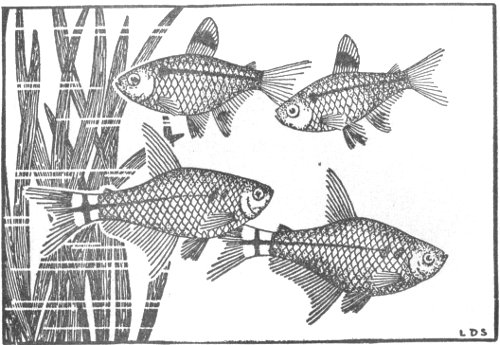
average size
Color: Silvery body, caudal reddish, anal and dorsal light yellow with dark spot. Difficult to distinguish sex.
Breeding Habits: Egg Layers. Spawn on fine plants, Myriophyllum or Cabomba—very small adhesive eggs, expelled 6 or 8 at a time, often fall to bottom. Sometimes as many as 200 eggs at a spawning. Remove parents after spawning.
Temperature: 72° to 80° F.; best above 75° F.
Maturity: About 1 year.
Temperament: Peaceful.
Color: Body translucent green, faint gold line through center of body, thin black line toward caudal base broadens into diamond shape. Gleaming gold spot on tail and brilliant red eye give fish its common name. Male smaller, more slender and has pointed instead of rounded dorsal.
Breeding Habits: Egg layers. Adhesive eggs are deposited on fine plants. Use 2 males to one female for best results. Fry hatch in 2 days. (See Pristella Riddlei.)
Temperature: 72° to 80° F.
Maturity: About 8 months.
Temperament: Peaceful. Young fairly hardy.
Color: Like above Pristella Riddlei but has a black and white line down the anal fin.
Breeding Habits and Temperament: like Pristella.
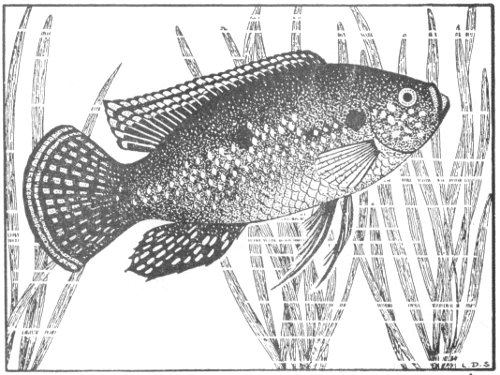
average size
Color: Body bright scarlet blending to rich olive on back. Emerald dots (jewels) in irregular lines cover body and vertical fins. Frequently difficult to obtain mated pair.
Breeding Habits: Egg layers—eggs are deposited on smooth stone or flower pot, to which they adhere. During incubation (about 30 hours) one parent stands guard, constantly fanning to circulate water over eggs. Fry are unable to swim first three days so parents make hollow in sand where fry are placed and guarded. After fry can swim, they form school with parents in center. Remove parents when fry are about one-fourth grown or sooner. Parents must not be excited or they will eat spawn or fry.
Temperature: 70° to 90° F. Fry above 75° F. Breed best at 80° F.
Maturity: 10 to 14 months.
Temperament: Very savage—male frequently attacks carefully mated female.
* * * * * * * *
To spawn Cichlids (Jewel, Angel, Orange Chromide, Blue Acara and Mouthbreeder) purchase several young fish—bring them to maturity together. When ready for breeding a mated pair will be found associating together and separated from the others.
Avoid disturbing Cichlids, any disturbance or noise may cause them to devour their eggs or young.
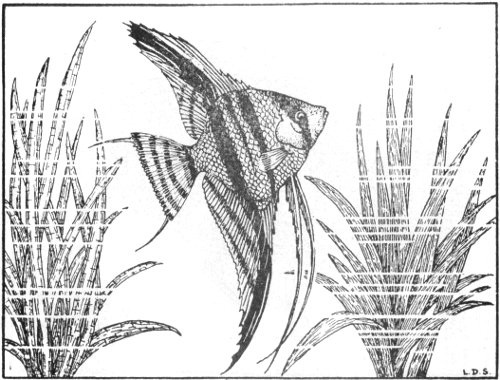
Reduced
Color: Bright silver, black bars, body very thin. Black bars disappear when disturbed or frightened. Difficult to distinguish sex.
Breeding Habits: Egg layers—very difficult to breed. Prefer sides of aquarium or Sagittaria Gigantea for depositing eggs. Eggs are fanned constantly by parents. Fry appear in about 8 days; guarded, and transferred from one plant to another or depression in sand, by parents. Fry swim in about a week and resemble thread like worms. Remove parents when fry begin to swim. Feed infusoria. Fry take shape of scalare in 3 to 5 weeks.
Temperature: 70° to 90° F. 85° for spawning.
Maturity: One to one and a half years. Growth depends upon quality and quantity of food and size of tank. Angel fish should have as much live food as possible, largest tank available.
Temperament: Peaceful. Easily frightened. Keep in large well planted aquarium otherwise they may dart against sides and kill themselves. Should be fed live food frequently. Large specimens are not recommended for community tank.
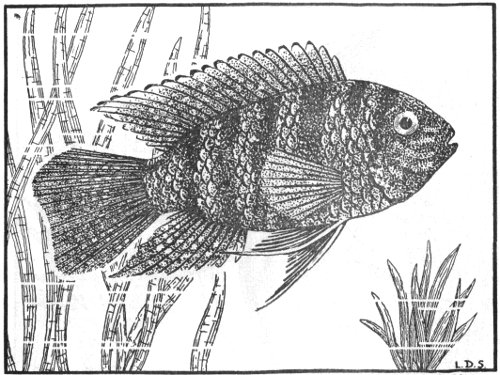
one half size
Color: Yellowish brown with several dark vertical bands. One of these bands widens in center of the body into a spot. Lines of shining blue dots cover the entire body. Dorsal, anal and caudal are wine red with rows of blue and blue-green spots. Both sexes similar, female slightly subdued in color.
Breeding Habits: Egg layers—Mate fish of approximately the same size. Provide a clean flower pot for the fish to deposit their spawn. The adhesive eggs are placed on the inside of the flower pot and are then fertilized by the male. Eggs are fanned by the parents and fry appear in 3 or 4 days. Parents prepare a depression in the sand and taking the newly hatched fry in their mouths deposit them into these holes where they are carefully guarded by the parents. Young live in a swarm in this “nest” for several days. Then they swim freely and must be fed infusoria. Parents may be removed soon after fry swim freely. The Blue Acara is hardy, prolific, easily spawned, and the fry are hardy and develop rapidly.
Temperature: 70° to 85° F.
Maturity: Breed in about 8 months.
Temperament: Not peaceful—except with very large fish.
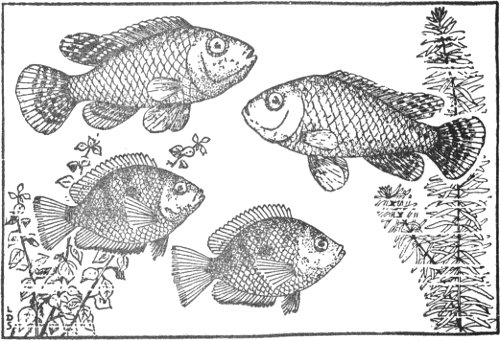
one half size
Color: Body light blue gray—fins yellowish—head very massive.
Breeding Habits: Egg layers—deposit spawn in depression in sand. After spawning is completed female picks up eggs and carries them in her mouth. Water is circulated over eggs by a chewing movement. Female refuses food during period she carries eggs. Male should be removed as soon as female picks up eggs as he may bother her. Fry appear in about two weeks, but at the slightest sign of danger rush back into the mother’s mouth. This continues until fry are too large for the maternal jaw. Female should be removed when fry are about 5 weeks old. Because of “fast” while carrying eggs, should be bred but 2 or 3 times a year.
Temperature: 70° to 85° F.
Maturity: 12 to 14 months.
Temperament: Rather vicious.
Color: Golden orange, 3 blue-black dots on sides crossed by rows of small reddish dots. Dorsal brown, anal and pectorals dark. Sex difficult to distinguish.
Breeding Habits: Egg layers—Spawn on flower pot or stones placed in the aquarium. Fry hatch in about 4 days and are moved into pits in sand. Fry swim freely in about 6 days. Remove parents in about two weeks.
Temperature: 70° to 80° F.
Maturity: about 6 to 8 months.
Temperament: Usually peaceful in large well planted tank.
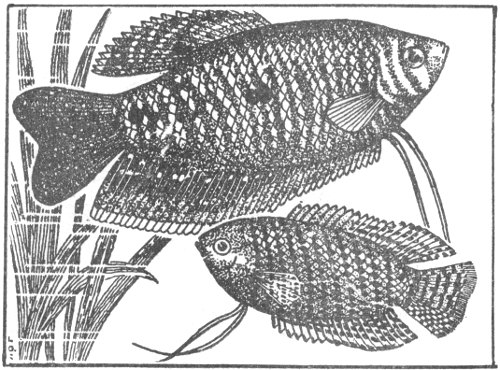
average size
Color: Silvery olive with black spot in center of body, another at caudal base—the eye making the third spot.
Breeding Habits: Same as Dwarf Gourami.
Temperature: 70° to 85° F.
Maturity: 10 months.
Temperament: Not recommended for community tank.
Form and size like three-spot gourami but color light blue.
Color: Body light blue crossed by orange-red stripes. Large fins colored same as body. Female—subdued in color and fins (dorsal and anal) slightly rounded.
Breeding Habits: Bubble nest builders—male blows nest of bubbles on surface of water among floating plants. Female frequently assists, weaving bits of plants into nest. Female is coaxed beneath nest where eggs are expelled and fertilized. Male catches eggs and blows them into bubble nest. Remove female. Eggs hatch in several days. Male guards nest, blowing fry back into nest until they are able to swim freely, to prevent their drowning. Remove male when fry are 4 days old.
Temperature: 70° to 90° F.
Maturity: 8 to 10 months.
Temperament: Exceedingly peaceful and friendly.
Labyrinth fish prefer shallow water—spawning tank not to exceed 6″—tank for fry not to exceed 4″.
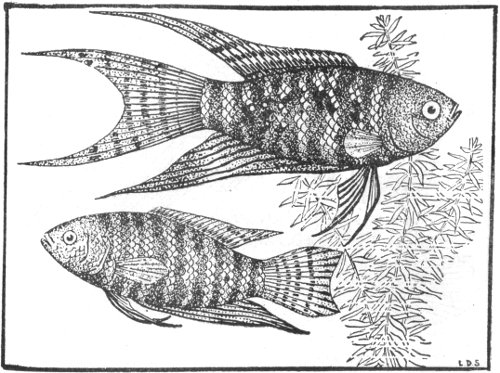
average size
Color: Body dark with vertical bars of deep red against bluish green background. Fins similar in color, caudal deep red. Female—shorter fins, color very pale during mating.
Breeding Habits: Bubble nest builder. When pair have mated (frequently after the death of several undesirable females) the male builds a floating nest of bubbles. Male coaxes female under nest, winds himself about her, a gentle pressure expelling eggs. He then gathers eggs in his mouth and blows them into nest. Falling eggs and young fry are carefully blown back into nest by male. Remove female when spawning is over. Fry appear within 36 hours. Remove male in about 4 days.
Temperature: 50° to 90° F.
Maturity: About 12 months.
Temperament: Vicious, keep pair separated except when spawning. (see Bettas.)
Labyrinth Fish (Gourami, Paradise, Bettas) are air breathers, coming to the surface every few minutes for a bubble of air. For this reason they can stand crowding, providing water is kept clear. Fry do not develop this characteristic for several weeks so must be provided with a large shallow container with ample oxygen.
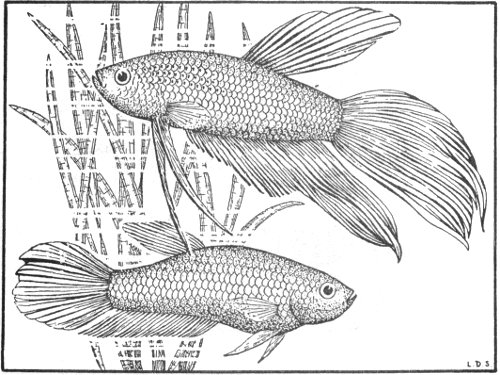
average size
Color: This attractive group (all hybrids of BETTA SPLENDENS) have many color variations, all exceptionally attractive. BETTA CAMBODIA: gold colored body—bright red fins. Those with most red in body known as BETTA RUBRA. BETTA CYANA—body and fins iridescent cornflower blue. Others often have various shades of blue, green, red and purple predominating. Females—subdued in color and lack long flowing fins.
Breeding Habits: Bubble nest builders—Male builds floating nest of bubbles 3 to 6 inches in diameter. Female is coaxed and forced under nest, male embraces her expelling eggs. Male catches eggs and blows them into bubble nest. Remove female. Fry hatch in 48 hours. Remove male in 10 days. Do not crowd fry.
Temperature: 65° to 90° F. 80° F. best for spawning.
Maturity: 8 to 10 months.
Temperament: Savage—two males will fight to a finish. Siamese wager on outcome of these battles. Not advisable to keep mated pairs together except when spawning. Separate pairs with glass placed diagonally across aquarium. When spawning, if male attacks female too viciously, replace glass.
(One of these fish may be kept in Community Tank—they seem to attack only their own species.)
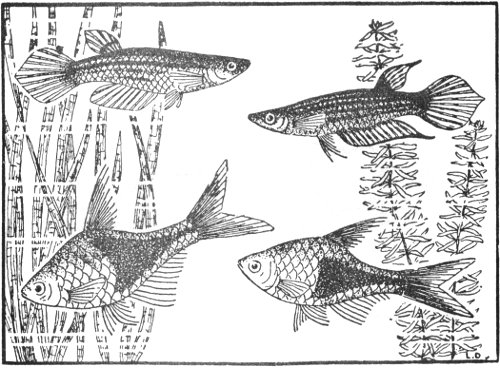
average size
Color: Male, rich deep greenish olive, sides covered with rows of gleaming red and green spots, anal bright orange and red. Dorsal and caudal are of similar colors. Female—dull with light orange fins.
Breeding Habits: Egg layers, spawn readily in small tank, riccia being a favorite plant for this purpose.
Temperature: 72° to 80° F.
Temperament: peaceful.
Color: Silvery copper with large blue-black triangle from dorsal to caudal base. Dorsal and caudal red. Scales above black triangle wider on male.
Breeding Habits: Egg layers—Difficult to breed. Female swims upside down against leaf of Cryptocoryne, expelling eggs, most of which drop to bottom. Remove parents after spawning. Fry hatch in about 2 days and resemble zebra fry. Swim freely in about 5 days. Use 3 males and 2 females. Do not have aquarium in direct rays of sun.
Temperature: 72° to 85° F.
Maturity: Breed at 10 months.
Temperament: Peaceful.
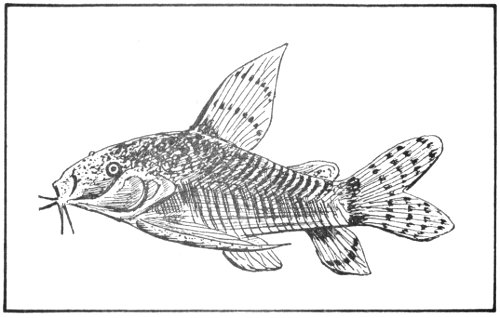
Color: Shining olive green, towards the anal: yellowish to white. Body covered with dark spots changing according to the surroundings. Average size: 1 to 2 inches.
Breeding Habits: Egg layer. Distinguishing sex marks: male smaller than female, and has pointed ventral fins, which are in the female, rounded. Best breeding results are obtained in a large aquarium. Two to three males for one female. Temperature 75 to 80 degrees. 60 to 500 eggs are carried by female in her ventral fins to a clean spot which can be the glass of the aquarium, a plant or stone. Babies hatch after 6 to 9 days. The opinion of breeders is divided as to whether parents should be removed. Good results were obtained either way.
Temperament: Paleatus Catfish are the most peaceful fish and very essential for the maintenance of every balanced aquarium. They are regarded as the officers of the “Dept. of Sanitation” among successful aquarists. Paleatus is a ground fish, tirelessly picking up food remnants and left-overs which other fish do not eat. Through this activity, Paleatus helps to keep the food particles from contaminating the water. Catfish dart up to the surface to breathe atmospheric air.
Color: Form and color similar to Pearl Danio but with gold and blue line from eye to caudal fin, dorsal and caudal fins deep red, male has white tip above red caudal fins.
Breeding Habits: Average temperature 80 degrees. Eggs not adhesive. One female to two males, eggs hatch after two to three days. Remove parents after spawning. Tiny fry must be supplied with infusoria or better still, Brine Shrimp (see p. 27).
Temperament: Peaceful and hearty, “called poorman’s Neon Tetra” since the bright colored babies closely resemble Neon Tetras.
Color: Generally white and the red bars show faintly. Like most albinos their eyes are pink.
Breeding Habits: Just like their original form, the Red Paradise. The albino color breeds true. (See page 23.)
Color: Same size like Tetra from Rio but black in color.
Breeding Habits and Temperament also like Tetra from Rio. (see page 16.)
Color: Sphenops are found in various color schemes varying from jet black to pure light blue, very often blue body with scattered black spots. The caudal of male adorned with bright orange border.
Breeding Habits: Heartier and more easily bred than ordinary Black Mollies.
Color: Body color of male and female light blue, but males dorsal shows “red, white and blue”.
Breeding Habits: (see page 11.)
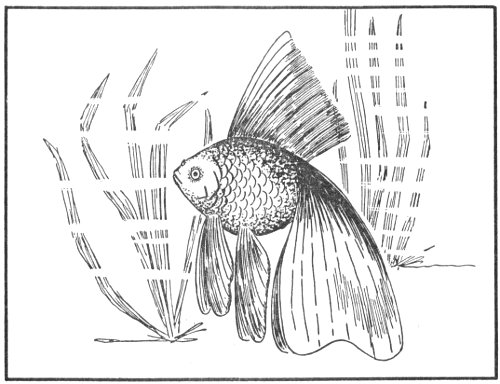
Veiltail
History: The Gold Fish, the oldest and most popular of our numerous Aquarium Fish, was developed by the Chinese during the Sung Dynasty (960-1278) from the wild Carassius Auratus to the various varieties now familiar to us.
In the year 1750 Madame de Pompadour imported the first Goldfish into France as showpieces for the ornamental waterpools in her vast gardens. In 1856, P. T. Barnum was sent by The American Museum to search for oddities in Europe and to study the then popular fad of keeping live fish in aquariums. Thus our now familiar Goldfish made its debut in America. With its golden beauty and its sturdiness, the Goldfish quickly became the Parlor Pet of our parents and grandparents. Today the sales of American-bred Goldfish run into the millions.
It would be beyond the limits of this booklet to explain and fully describe all the various forms and color variations of our goldfish, as there are Comets, Fantails, Shubunkins, Black Moors, etc. Most Goldfish do not reach their full life span of 4 to 6 years and often more, because they are fed too much and are given too little “Living Space.” Feed your fish only once a day during the morning and make sure that all food is consumed within 10 to 15 minutes. Any surplus food will fall to the bottom and will contaminate the water. The surest sign of overfeeding is cloudy and milky looking water. This bad water is poor in oxygen and the fish will hang on the surface and frantically gasp for atmospheric air. Any nationally known brand of Goldfish food will be suitable for your fish, but once more: DO NOT OVERFEED. The proper size of the aquarium should be comparable to the amount of fish or vice versa. The happy medium is about 1 small fish per gallon of water. An aquarium of five gallons capacity can, therefore, hold no more than 4 to 5 small Goldfish, but fish of larger size must have much larger space. The most suitable temperature is between 60 and 70 degrees, Fahrenheit.
Breeding Hints: During the breeding season which falls during the first seven months of the year, the male will show small warts of pin point size on his gill plates. The female is shorter than the male but fuller in body, more so, when carrying spawn. A mature fish is about 3-10 inches long, depending on type and a pair must therefore have a breeding aquarium of at least 10 gallons. The fish will spawn on myriophyllum, long rooted water hyacinths, or other soft bunchy plants and the eggs will hatch in about 4-7 days. Since the parent fish like to eat their own spawn, it is therefore advisable to remove either the parents or the plants with their adhering eggs. The newly hatched babies are fed with infusoria and later on with fish food of a fine grain.
Diseases: Fin Congestion and Fungus are the most frequent Goldfish diseases. Their best cure is the salt treatment which is described on page 33.
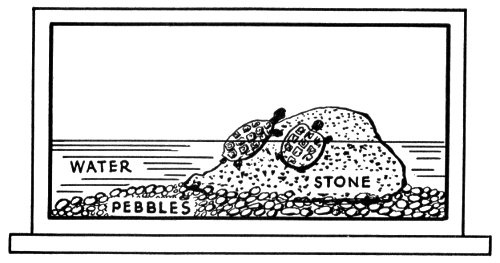
Baby turtles are very easily kept as pets and require little care. While in captivity, Turtles will forget their time schedule and will not hibernate. Any round or oval bowl, an aquarium or a flat pan with a rim sufficiently high to prevent the turtle from crawling out, is an adequate home. In this container, place white or colored pebbles, and in the center a flat stone. Fill the container with clean water of room temperature (60 to 80 degrees, fahrenheit) but see to it that the stone is not covered by the water for it will serve as an “Island” and thus give the turtle a chance to leave the wet element when desired. The best place for the bowl is in a light place, but special care should be taken to see that the bowl is not exposed too long to the direct sun. Ant Eggs, commonly packed as “Turtle Food” will mainly be their diet but lean raw beef, which is finely scraped, will be an appreciated change. The same applies for green lettuce, rainworms, etc. A variation in food and sunshine will prevent blindness, but should a turtle get a white film over its eyes, a few drops of Cod liver Oil forced by a medicine dropper in its mouth, might help. Boric acid swabbed over the eyes will also be beneficial. Turtles will not feed “on land” therefore all food should be placed in the water. Water should be changed two to three times weekly.
It is much easier to keep fish healthy than to cure them.
Disturb your fish as little as possible.
Fish in good health are active and keep dorsal fin erect. (Folded fins for a short period do not mean a sick fish.)
Most fish ills develop from chills. Keep fish above lowest safe temperature. Young fry especially should be kept warm.
Avoid extremes of temperature. Avoid sudden changes of temperature. Provide some type of aquarium heater for cold months.
Do not crowd fish—be sure plants are thriving and there is ample oxygen in water.
Fish constantly at top indicate foul water and lack of oxygen. Remove part of water and replace with fresh of same temperature.
Dying plants cause much trouble—be sure plants are healthy and growing.
It is much easier to keep fish healthy in a large tank (above 5 gallons). A large tank maintains a more uniform temperature, allows more air surface, plants thrive better, and water is not fouled so easily by excess food.
An aquarium can be maintained in healthy condition, both plants and fish thriving, under artificial lighting furnished by an ordinary light bulb.
Vary the diet for the fish. Feed only as much as they will eat in ten minutes. Feed sparingly and several times a day if necessary. Use glass feeding ring. (Fig. 4). All uneaten food drops to one spot where it can be easily removed with a dip tube.
Health and growth of fry depend upon oxygen supply. Use tank with large air surface. BE SURE AND DO NOT CROWD YOUNG FRY. Crowding stunts growth and frequently causes disease, and loss of whole brood. Fry demand approximately same amount of water as adults—see page 31.
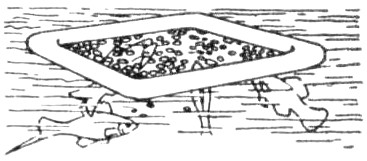
FIG·4
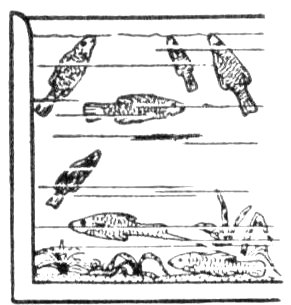
Tropicals in poor condition, (usually indicated by folded fins).
Fish constantly at top indicate foul water and lack of oxygen.
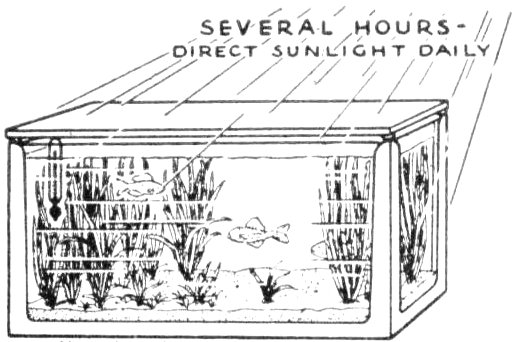
SEVERAL HOURS DIRECT SUNLIGHT DAILY
Always keep glass cover on aquarium.
Always keep a thermometer in aquarium.
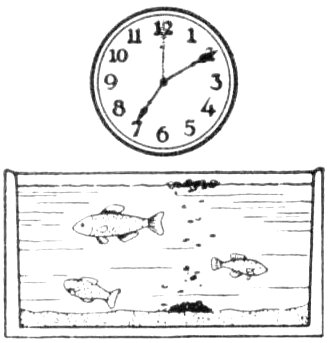
Never give fish more food than they can clean up in ten minutes.
Do Not Overfeed—Never give fish more food than they can clean up in ten minutes.
Vary the Diet—Have several kinds of food on hand at all times. Dried Shrimp, Dried Daphnae, scrapings from raw beef, bits of canned salmon, bits of boiled spinach, finely crumbed graham cracker, bits of yolk of boiled egg, and most of the prepared foods are excellent but should be supplemented with some form of live food. Once a week they should be fed chopped earth worms or Enchytrae (White worms). Feed live bearer’s fry small quantity of fine foods several times a day. Feed egg layer’s fry Brine Shrimp twice a day the first couple weeks and then feed same as live bearer’s fry.
Several Feedings a Day—Feeding a very small quantity of food several times a day (what the fish will clean up in several minutes) is probably more desirable than one feeding providing great care is taken not to feed too much at one time.
Tropicals Will Not Overeat—Unlike goldfish, tropicals will eat only as much as they need but great care must be exercised in order to allow no uneaten food in the aquarium to foul the water and cause disease.
Tubifex worms are found in fresh water streams and rivers, close to shore in soft loamy bottom. They are an excellent live food provided they are fed to the fish with care. Keep in cool place in container having large air surface with just enough water to cover them. Since they bury themselves in the gravel, it is best to feed them to the fish with a worm feeder. The best type of feeder has a quantity of small holes through which the worms wriggle into the mouths of the fish eagerly waiting below. For baby fish it is best to cut the worms into small pieces.
Enchytrae (White Worms) multiply rapidly in a wooden box (about 10″ square) filled with about 5″ of rich loamy soil. Portion of worms is placed in soil and whole mass kept fairly moist. Feed slice of bread soaked in sweet or sour milk every 3 or 4 days. Be sure all food is covered with at least 1″ of soil. Before feeding be sure all old food is consumed. They may be fed cooked oatmeal or mashed potatoes WITHOUT SALT. Stir soil once a week to aerate it and prevent souring. Cover soil with piece of glass to keep moisture in. Keep in cool dark place.
BRINE SHRIMP—To raise Egglaying Fish, the use of Brine Shrimp (fig. 5) replaces the old fashioned Infusoria method more and more. Brine Shrimp Eggs are available in any good pet shop and are easily hatched. Directions for hatching Brine Shrimp Eggs are found on package.
Tropical Fish are naturally healthy. If kept in a healthy aquarium, fed properly and kept warm little or no trouble will be experienced. In short—IT IS EASIER TO KEEP FISH HEALTHY THAN TO CURE THEM.
Practically all diseases are due to one of the following: UNHEALTHY TANK—water too acid or alkaline—lack of oxygen—decomposition of food—plants not thriving. IMPROPER FEEDING—Overfeeding, lack of live food, lack of variation in diet. CHILL—the cause of most fish ills. Fish is weakened and subject to diseases, many incurable.
Ichthyopthirius (Ich): A parasite that attacks the fish. Recognized by tiny white spot on fins. Fish have fins folded and scratch themselves on sand. Contagious. Treat whole tank (plants and snails need not be removed). Raise temperature to 80° F. Add about two drops 2% Mercurochrome to each gallon of water. If fish are not cured in 3 or 4 days repeat treatment.
Shimmy: A wagging movement without changing position is usually the result of a chill affecting digestive organs. Not contagious—give salt treatment.
Dropsy: Body swells, scales stand out at an angle. Fish act normal until a few days before death. Salt treatment sometimes brings relief. Cure doubtful.
Wounds or Ulcers: Wrap piece of cotton on toothpick; hold fish in damp cloth and paint wound for 2 minutes with Mercurochrome twice a day. Do not allow Mercurochrome to touch gills.
Constipation: 1 tablespoon Epsom Salts to 5 gallons of water.
Air Bladder Trouble: Caused by sudden temperature change. Fish swim either at top or stay near bottom. Cure unknown.
Blood Shot Fins—Tailrot: Condition caused by sudden temperature change or injury. Use salt treatment.
Fungus—White scum forms over fish. Use salt treatment.
Fluke: Flat and sunken belly. No known cure.
Salt Treatment: Use glass or enamel container, raise temperature to 80° F., 1 teaspoonful rock or sea salt per gallon of water. (May be doubled in extreme cases.) Salt (Rock or Epsom) will kill snails and plants.
Tropicals in poor condition, usually indicated by folded fins, should be isolated at once. Gradually raise temperature to 80° F. Feed live food. Give salt treatment. Frequently a cure is affected by placing ailing fish in tank of “green water.” (see page 31.)
Sick fish more easily cured in shallow water.
Sudden changes of temperature may be fatal to weakened fish.
Potassium permanganate solution is an excellent disinfectant and deodorant. Also destroys algae in aquarium and pool. Tint water faint pink, repeat when color disappears. Avoid excess.
Fish enemies are usually transferred to the aquarium by the introduction of new aquatic plants that are obtained from outside pools. To avoid fish enemies—AVOID USING PLANTS AND SAND THAT ARE OBTAINED FROM OUTSIDE POOLS OR PONDS. If you are suspicious of source rinse for a minute or two through a strong solution of salt water. This should kill all insects and not injure plants. Examine plants carefully for eggs. Fig. 6 shows larvae of Giant Beetle (Water Tiger). Fig. 7, larvae of Dragon Fly. Both attack fairly large fish and devour small ones in quantities.
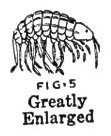
FIG·5

FIG·6
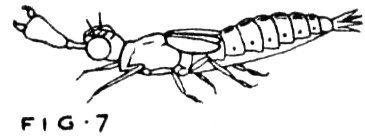
FIG·7
HYDRA—a polyp, fastens itself to plants or glass. It has a variety of shapes and is hard to distinguish particularly on plants. It attacks and quickly drugs fish by injecting a poison. Hydra can be killed by removing all fish and scavengers and raising temperature of tank to 115° F.
Replacing consumed oxygen by blowing a stream of very fine air bubbles through the aquarium water is frequently necessary in aquariums, where plants receive insufficient light or are not thriving, where the air surface is small (depth greater than width), where crowding is necessary, etc. Even in healthy aquariums, where plants are thriving, conditions will be improved by an hour or two of aeration daily. Many types of aerators are available.
Due to the fact that in some localities the natural water supply is alkaline, in others neutral, and in others acid much has been written about controlling aquarium water.
Many aquarists believe that a slightly acid condition in the aquarium is desirable.
There are a number of reliable water testing sets available at very nominal prices.
Most of the fish described in this book seem to thrive and breed better in slightly acid water (about pH6.8).
Get your experience from the more common varieties first.
Half grown fish are best to buy—you are sure of obtaining young fish, and it is interesting to watch them mature.
Fish ready to spawn: Females become heavier. Also on live bearers the dark spot near vent becomes larger and darker. Males chase females continually at spawning time. Labyrinth male builds bubble nest.
Live bearers are easiest to breed. Eggs are hatched within the female’s body and the young are born alive.
Female live bearers seek secluded places to give birth to their young. If one corner of the community tank (toward light) is heavily planted, and ample floating plants provided, quite a few young will survive. These can be removed until old enough to return to community tank—in about 4 or 5 weeks, dependent on growth.
Female live bearers will eat their young. If placed in separate tank remove female as soon as brood is produced.
Female live bearers will produce several broods after being separated from male.
Live bearer’s fry are sometimes born with an “egg sac,” usually the result of premature birth.
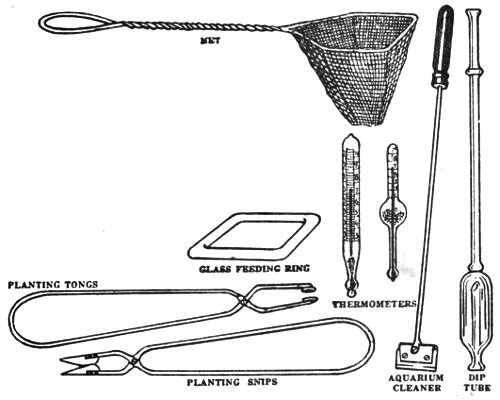
Tools

AVOID
1·SUDDEN TEMPERATURE CHANGE.
2·CROWDING LACK OF OXYGEN.
3·EXCESS FOOD.
To save young live bearers, females are frequently placed in a trap. Be sure female has ample room to swim freely. Many varieties of traps are available.
To breed egg layers, male and female should be separated for several days before being placed in spawning tank.
All fish are more prolific during warm weather.
Practically all fish will eat young fry.
Algae—a fine green plant growth—is caused by an excess of light. Remove as much of the growth as possible and reduce amount of light.
Floating algae—green water—is caused by the same condition. Cut down light and condition usually clears itself. (See page 4.) Coloring water in tank a faint pink with a solution of potassium permanganate will usually clear this condition. Green water is actual healthy water for fish.
Algae may be cleaned off glass by scraping with safety razor blade. (Fig. 8.)
Cloudy water usually caused by improperly balanced tank. Remedy: more plants or less fish, better light, more scavengers, less food.
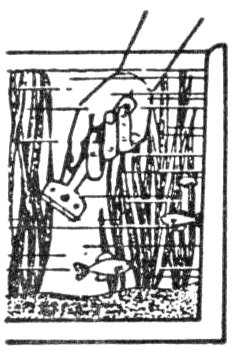
FIG·8
Cloud at bottom of tank is usually caused by decaying of excess food.
Plants thrive better in deep sand; roots spread and absorb decaying matter.
Always use sea salt. Table salt is questionable since it is chemically treated to prevent caking.
Tropicals thrive under more crowded conditions than goldfish. 2 or 3 pairs per gallon in healthy aquarium, about 6″ fish body per gallon.
Always sterilize net with boiling water after handling sick fish.
Slow leaks in aquariums will usually be sealed by painting all inside and outside seams with liquid aquarium cement.
To obtain number of gallons of water in tank—divide cubic contents in inches by 231.
* Subjects marked * are illustrated
A B C D E F G H I J K L M N O P Q R S T U V W X Y Z